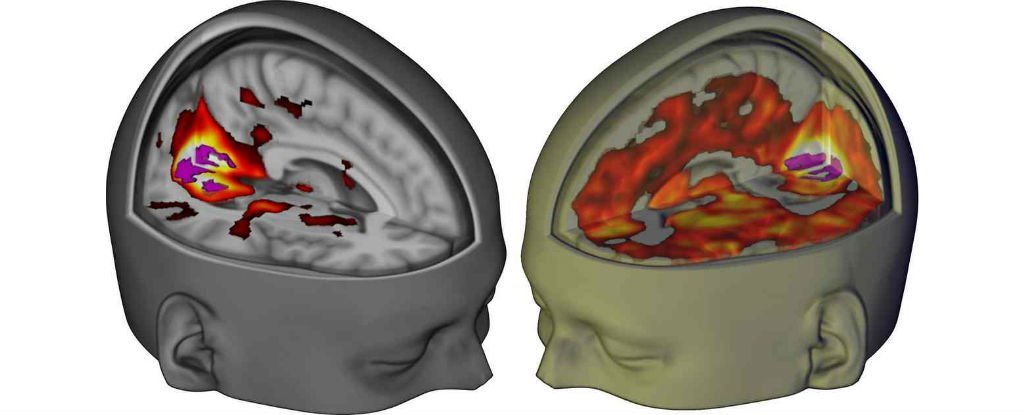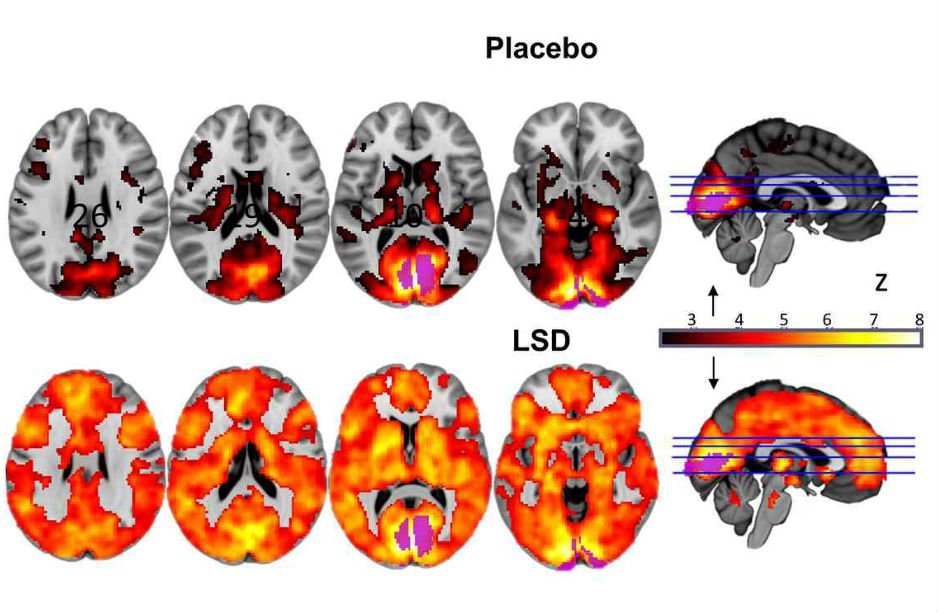Brain scans show how LSD acts on consciousness
Professor Nutt: “For neuroscience, this is akin to the discovery of the Higgs boson in physics”

A stunning scientific paper published in the journal Proceedings of the National Academy of Sciences (10.1073 / pnas.1518377113). Now it becomes clearer why Steve Jobs considered LSD to be " one of the two or three most important things in his life ."
So, a multimodal scan revealed that one of the most powerful hallucinogens created by man not only affects the visual cortex, as previously assumed, but also links together various areas of the brain that are usually isolated from each other ! The illustration above shows how, under the influence of LSD (on the right), the connection between the visual cortex and other areas significantly increases. In the left picture - the brain of a person who took a placebo.
Just look at these pictures.
')

The study was conducted by David Nutt, a professor of neuropsychopharmacology at Imperial College London, and a former adviser on drug policy to the UK government, who was dismissed in 2009 for criticizing the authorities' decision to toughen penalties for marijuana.
It took nine months to get permission to conduct an experience on the UK ethics committee .
Together with a colleague Robin Carhart-Harris (Robin Carhart-Harris) Nutt invited 20 healthy volunteers who agreed to risk health for the sake of science. Each of them received 75 micrograms (0.075 mg) of LSD on one day and placebo on another.
Scientists used three different brain scanning techniques — arterial back marking, MRI at rest, and magnetoencephalography — to understand what was going on. The scan lasted eight hours - the so-called “long trip” of LSD (for comparison, psilocybin - only four hours). Only 15 volunteers managed to get full data, because the other five were moving too actively.
The results were unexpected. It turned out that after taking LSD, the processing of visual information in the brain is no longer limited to the visual cortex. All areas of the brain begin to participate in the formation of visual images in patients. This is especially interesting given the fact that their eyes were closed .
“We observed changes in the brain, meaning that our volunteers“ see with their eyes closed, ”although the images they see come from the imagination and not from the outside world, explains Karhart-Harris . “We observed that much more brain areas than usual are involved in the processing of visual information.”
Besides the fact that some areas of the brain, usually separated, now began to work together, but also some usually connected areas were isolated from each other. This fact is related to the well-known effect of LSD - the loss of personal identity, that is, the dissolution of the ego.
“Usually our brain consists of independent networks that perform independent specialized functions, such as sight, movement, and hearing, as well as more complex functions, like attention,” says Karhart-Harris. “However, under LSD, the isolation of these networks disappears, and instead a more integrated or unified brain is obtained. The brain functions in a simpler way. ”
“For neuroscience, this is akin to the discovery of the Higgs boson in physics,” said David Nutt.
The Swiss colleague Matthias Liechti, a drug researcher from the University of Basel, agrees with him: “This is a landmark study, ” he says . “It looks like LSD research continues despite the barriers to regulation and financing.”
Neurobiologists around the world have been waiting for this moment for 50 years, and this experiment was made possible thanks to a crowdfunding campaign .
Scientists say that it is very important to better understand the incredibly strong and unique effects of LSD, because otherwise we will not be able to evaluate the possible therapeutic effects of psychedelics for the treatment of mental disorders, such as depression and drug and alcohol addiction , or even asthma .
“We finally uncovered the brain mechanisms that underlie the potential of LSD not only for treatment, but in general, for a better understanding of consciousness itself,” said Amanda Feilding, director of the British Beckley Charitable Foundation, in a press statement. partially financed the work.
In the following experiments, Professor Nutt plans to study the effect of LSD on creativity and how much the state of the trip is like a dream.
Source: https://habr.com/ru/post/392939/
All Articles